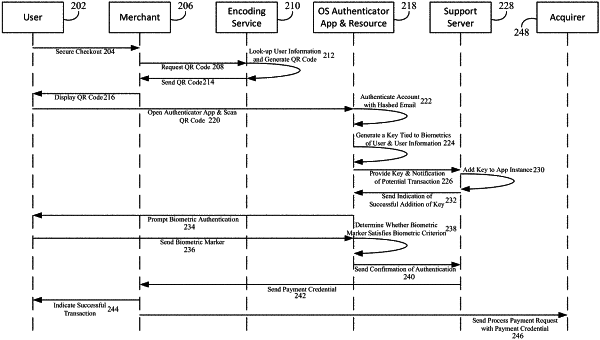| CPC G06Q 20/40145 (2013.01) [G06F 21/44 (2013.01); G06K 7/1417 (2013.01); G06Q 20/3276 (2013.01); G06Q 20/3829 (2013.01); G06Q 30/0185 (2013.01); G06Q 2220/00 (2013.01)] | 13 Claims |

|
1. A method of payment-supporting authentication, comprising:
managing, via an authenticator application, a resource with information about registered users;
receiving, via the authenticator application accessing a camera and capturing a photograph or accessing stored photographs on a user device, a captured QR code comprising user identifiable information and information of a potential transaction;
decoding, via the authenticator application, the captured QR code to obtain the user identifiable information and the information of the potential transaction;
upon decoding the captured QR code, receiving, via a graphical user interface of the authenticator application, an indication to authenticate a user from input of the user;
authenticating, via the authenticator application, the user using the user identifiable information and the information stored in the resource;
upon authenticating the user using the user identifiable information and the information stored in the resource, generating, via the authenticator application, a key tied to existing biometric authentication of the user and mapped to the user identifiable information;
communicating, via the authenticator application, with a support server to provide the key and a notification of the potential transaction;
prompting, via the graphical user interface of the authenticator application, the user to provide a biometric marker via the user device;
receiving, via the authenticator application accessing a biometric scanner or microphone of the user device, the biometric marker from the user after authenticating the user using the user identifiable information and the information stored in the resource;
determining, via the authenticator application, whether the biometric marker received from the user satisfies a biometric criterion based on the existing biometric authentication of the user; and
upon the determination that the biometric criterion is satisfied, communicating, via the authenticator application, with the support server to enable the potential transaction to be performed.
|